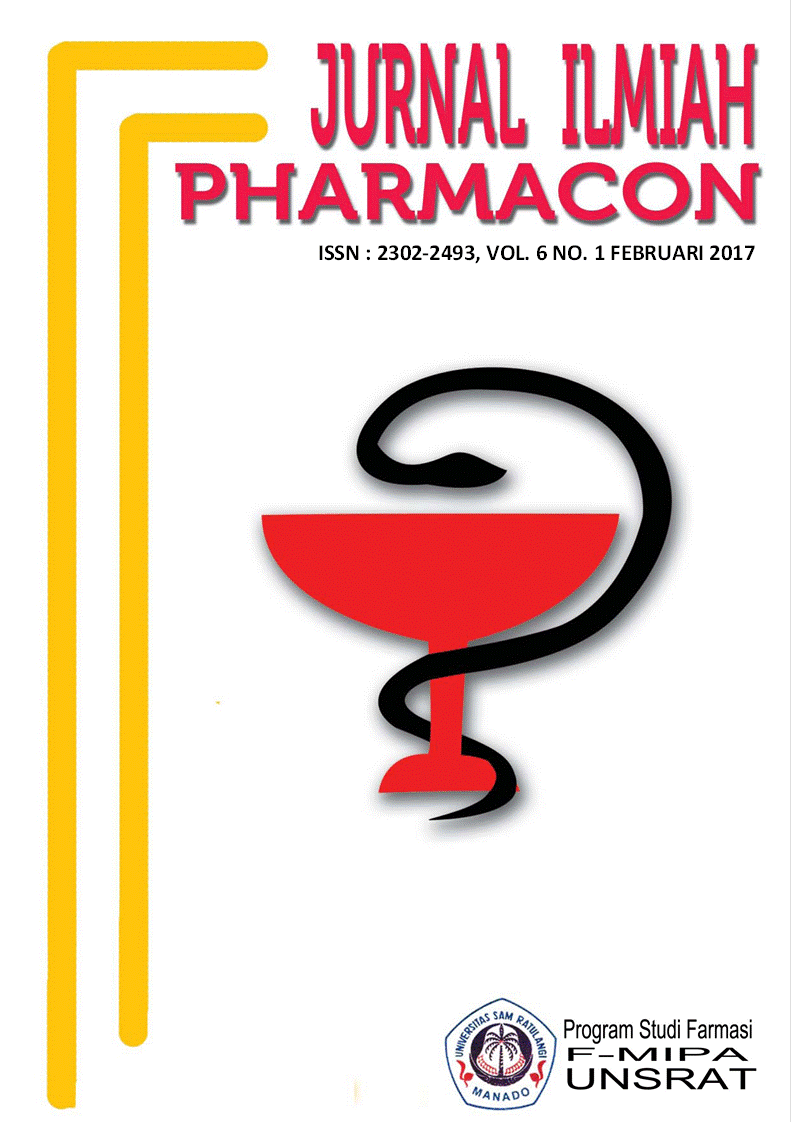FORMULASI DAN UJI ANTIBAKTERI SEDIAAN SABUN CAIR EKSTRAK DAUN KEMANGI (Ocymum basilicum L.) TERHADAP BAKTERI Staphylococcus aureus
DOI:
https://doi.org/10.35799/pha.6.2017.19731Abstract
FORMULASI DAN UJI ANTIBAKTERI SEDIAAN SABUN CAIR EKSTRAK DAUN KEMANGI (Ocymum basilicum L.) TERHADAP BAKTERI Staphylococcus aureus
Paulina V. Y. Yamlean1) dan Widdhi Bodhi1)
1)Program Studi Farmasi FMIPA UNSRAT Manado, 95115
ABSTRACT
Basil leaf has active compounds such as essential oils, alkaloids, saponins, flavonoids , triterpenoids , steroids, tannins and phenols. Some of these chemical ingredients can inhibit the growth of Escherichiacoli , Staphylococcus aureus , and Klebsiellapneumonia bacteria such as alkaloid compounds, atsiridan oil and phenols. The aim of this research is to formulate the liquid soap from the ethanol extract of Basil leaf and to test the antibacterial effectiveness of liquid soap from the ethanol extract of Basil leaf with concentration of 3%, 6% and 9% to Staphylococcus aureus bacteria growth. Liquid soap formulations from the ethanol extract of Basil leaf with concentration 3%, 6% and 9% then done by organoleptic test, pH, high foam, moisture content, free alkali and weight type test. Testing of antibacterial effectiveness on growth of Staphylococcus aureus was done by diffusion method. The results of quality test of liquid soap that meets the requirements according to standard of SNI were organoleptic test, pH, high foam, moisture content, free alkali and weight type test. The results of antibacterial effectiveness test of liquid soap from the ethanol extract of Basil leaf obtained that can inhibit Staphylococcus aureus bacteria, that is with concentration 3%, 6% and 9% which fall into category of strong inhibition zone.
Word Keywords : Basil Leaf, Liquid Soap, Antibacterial Effectiveness Test
ABSTRAK
Daun Kemangi memiliki senyawa aktif sepertiminyak atsiri, alkaloid, saponin, flavonoid,triterpenoid, steroid, tannin dan fenol. Beberapagolongan kandungan kimia tersebut dapatmenghambat pertumbuhan bakteri Escherichiacoli, Staphylococcus aureus, dan Klebsiellapneumonia seperti senyawa alkaloid, minyak atsiridan fenol. Penelitian ini bertujuan untuk memformulasi sediaan sabun cair ekstrak etanol daun Kemangi dan menguji efektivitas antibakteri sabun cair ekstrak etanol daun Kemangi dengan konsentrasi 3%, 6% dan 9% terhadap pertumbuhan bakteri Staphylococcus aureus. Formulasi sabun cair ekstrak etanol daun Kemangi dengan konsentrasi 3%, 6% dan 9% dilakukan pengujian organoleptik, pH, tinggi busa, kadar air, kadar alkali bebas dan bobot jenis. Pengujian efektivitas antibakteri terhadap pertumbuhan Staphylococcus aureus dilakukan dengan metode difusi. Hasil pengujian mutu sabun cair yang memenuhi persyaratan sesuai standar yang ditetapkan SNI ialah uji organoleptik, pH, tinggi busa, kadar air, kadar alkali bebas dan bobot jenis. Hasil uji efektivitas antibakteri sabun cair ekstrak etanol daun Kemangi yang diperoleh dapat menghambat bakteri Staphylococcus aureus, yakni dengan konsentrasi 3%, 6% dan 9% masuk dalam kategori zona hambat yang kuat.
Kata Kunci: Daun Kemangi, Sabun Cair, Uji Efektivitas Antibakteri
Â
Downloads
Published
How to Cite
Issue
Section
License
Authors who publish with this journal agree to the following terms:
- Authors retain copyright and grant the journal right of first publication with the work simultaneously licensed under a Creative Commons Attribution-NonCommercial 4.0 International License that allows others to share the work with an acknowledgement of the work's authorship and initial publication in this journal.
- Authors are permitted and encouraged to post their work online (e.g., in institutional repositories or on their website) prior to and during the submission process, as it can lead to productive exchanges, as well as earlier and greater citation of published work (See The Effect of Open Access)










